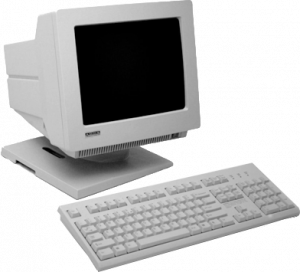CRT:ADDS 4000
| Information | ||
|---|---|---|
| Manufacturer | Boundless Technologies | |
| Type | Text Terminal | |
| Size | 14" | |
| 240p/480i | No | |
| 480p | No | |
| 720p | No | |
| 1080i | No | |
| Vsync | 60hz/71hz/82hz/100hz | |
| Widescreen | No | |
| Dimensions | Width: 318mm
Depth: 330mm Height: 340mm | |
| Weight | 29 lbs | |
| Earliest Date | 1997 | |
| Links | ||
| Operation Manual | ADDS 4000
ADDS 4000/110 ADDS 4000/160 ADDS 4000/260 ADDS 4000/260 LF/LFC Ethernet Adapter |
|
| Brochure | ADDS 4000
ADDS 4000/110 ADDS 4000/150 ADDS 4000-160 ADDS 4000-260 ADDS 4000-260 (alt) ADDS 4000 LFC |
|
The ADDS 4000 series is a series of text-only terminals with a monochrome screen that came in page-white, amber, or green colors. Named after the manufacturer "Applied Digital Data Systems" (later renamed to Boundless Technologies), they are compatible with PC101/102/106/107 or ANSI VT-220 keyboards via RJ11 connector on the left side.
Supported Terminal Emulators
The ADDS 4000 series is capable of emulating various terminals depending on model listed below[1].
| Model | Emulators Available |
|---|---|
| ADDS 4000/110 | ADDS Viewpoint A1, A2, 3A, 3A+; Lear Siegler ADM 3A |
| ADDS 4000/150 | ADDS Viewpoint and Regent 40; Wyse WY-50, WY-75, TeleVideo TVI-910, TVI-920,TVI-925; Hazeltine HZ-1500; DEC VT52, VT100; PCTerm |
| ADDS 60 | ADDS Viewpoint, AT 386 (Unix console), DEC VT100, VT220, VT320, Wyse WY-50/50+ WY-60, TeleVideo TVI 925, PC Term, SCO Console, BBS ANSI, Wordperfect Graphics |
| ADDS 4000 | ADDS Viewpoint and Regent 40; Wyse WY-50, WY-75, TeleVideo TVI-910, TVI-920,TVI-925; Hazeltine HZ-1500; DEC VT52, VT100; PCTerm, SCO Console |
| ADDS 4000/160 | ADDS Viewpoint, ADDS Viewpoint 60, DEC VT100, VT220, VT320, VT420 PC TERM, Wyse WY-50/50+, WY-60 TeleVideo TVI 925, PC Term (925 PC) |
| ADDS 4000/260 | ADDS Viewpoint, DEC VT100, VT220, VT320, Wyse WY-50/50+, WY-60 TeleVideo TVI 925, PC Term (925 PC), SCO console, AT 386 (UNIX console), WordPerfect graphics |
| ADDS 4000/260LF | ADDS Viewpoint, AT 386 (Unix console) DEC VT100, VT220, VT320, Wyse WY-50/50+, WY-60, TeleVideo TVI 925, PC Term, SCO Console, WordPerfect graphics |
| ADDS 4000/260LFC | Same as 4000/260LF plus WY-325, WY-350 |
| ADDS C1099A | HP 700/96 (factory default); Wyse WY-60, WY-50/50+, DEC VT320, VT220, VT100; ADDS Viewpoint, PCTerm (925 PC); TeleVideo TVI-925; SCO console, AT 386 (UNIX console) |
| ADDS 3153 | IBM 3151, Wyse WY-60, WY-50/50+, DEC VT320, VT220, VT100; ADDS Viewpoint, PCTerm (925 PC); TeleVideo TVI-925; SCO console, AT 386 (UNIX console) |
| ADDS 3153 LF | Same as ADDS 3153 |
| VT510, VT520, VT525, Dorio 10 | ADDS Viewpoint; DEC VT-100, VT220, VT320, Dorio 10; Wyse WY-50/50+ , WY-55, WY-60/160, WY-120/150; TeleVideo TVI 910+ , TVI 925/950; SCO Console |
Connecting to Linux Machine
The easiest way to connect the terminal to a Linux machine — such as a Raspberry Pi — is to obtain a DB-25 male to DB-9 female null modem cable and a DB-9 male to USB adapter cable. You must get one labelled "null modem", as it is cross wired to be used without a modem.
Connect the cables to each other, one end to the terminal's EIA port (fastest), and the other to a USB port on your Linux host device.
Terminal Setup
- Press
Ctrl + Scroll Lock(may be "PrLne" or "PrMsg" on your keyboard) to access Setup menu. - Press F1 to enter Quick menu (if not already selected). Set the following:
Host/Printer=EIA/None (enables EIA port to be connected to Linux host)
- Press F2 to enter General menu. Set the following:
Emulation=VT100(and optional settings to turn down the bell noise and set a screen saver to protect the CRT)
- Press F3 to enter Display menu. Set the following:
Display Cursor=OnPage Length=24Screen Length=26Columns=80
- Press F4 to enter Keyboard menu. Set the following:
Key Mode=ASCII
- Press F6 to enter Ports menu. Set the following:
EIA Baud Rate=115200 (if not available, note the value you choose)EIA Xmt=Xon-XoffEIA Data Format=8/1/NEIA Recv=Xany-Xoff(XPC)EIA Parity Check=OffEIA Xmt Pace=Baud
- Press F7 to enter Host menu. Set the following:
Comm Mode=Full Duplex
- Press F9 to enter Emulation menu. Set the following:
ANSI-ID=VT100 (this will identify the terminal as a VT100 terminal to Linux)Status Line=Off (recommended to prevent burn-in with line/text at top of screen)
- Press F13 (may be "Print" or "Print Screen" on your keyboard) to enter Exec menu.
- Press Enter on "Save Terminal" and wait for "DONE" message.
- Press Enter on "Save Session" and wait for "DONE" message.
- Press F14 (may be "Hold", "Break", or "Pause" on your keyboard) and Y to save and exit.
Linux Setup
- Enable the terminal console to be accessible by serial.
- On a Raspberry Pi, this can be set by running
sudo raspi-configand enabling the "Serial Port" option under Interface Options; or by runningsudo vi /boot/config.txtand adding an[all]section at the bottom followed byenable_uart=1.
- On a Raspberry Pi, this can be set by running
- Enable the USB serial port and set the baud rate to match the one you had set in the previous section.
- On a Raspberry Pi, you can do this by entering the commands:
sudo stty -F /dev/ttyUSB0 115200sudo systemctl enable [email protected]sudo systemctl start [email protected]
- On a Raspberry Pi, you can do this by entering the commands:
- If a login prompt isn't shown on the physical terminal, reboot the physical terminal followed by the Linux machine and it should prompt you for a login on the physical terminal.
